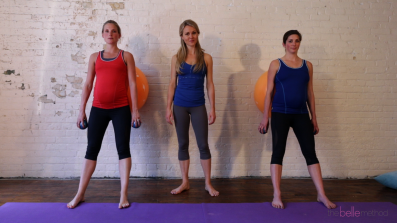I was recently a guest health expert on the YouTube talk show Social Common. And oh, did I ever have a blast with the fabulous hosts Cat and Nat. They didn’t hold back on the questions about kegels, coming out of child birth “unscathed” and “vagina rehab” (aka Pelvic Health Physiotherapy). Sexologist Dr. Jess O’Reilly joined in afterwards for some extra tips. It was quite the uncensored show and will hopefully make you laugh while perhaps teaching you some new things 🙂 Check it out here!
As many of you know, we work closely with incredible practitioners called Pelvic Health Physiotherapists to help our clients get the best possible results from their fitness training. These practitioners are specially licensed health professionals who offer both external and internal physiotherapy to help women prepare for and recover from childbirth, treat pelvic pain, incontinence, “mummy tummy”, and a host of other conditions that too many often suffer from silently. Well, not any more! Times are changing, and I’m so passionate about spreading the word that there is help. It’s never too late to restore your core, so if you’re reading this and your kids are in their teens or beyond, keep reading. The following is an article written by Anita Vandenberg, an incredibly compassionate Pelvic Health Physiotherapist here in Toronto, and soon to be mama herself! If you are pregnant, you may have googled – “safe exercises during pregnancy” – and what you likely found is overwhelming AND conflicting. So what are you to do? It’s important to seek out experts in the area of prenatal fitness, BUT also ask questions about their training, credentials and up to date research and education. We are frequently learning new information regarding exercise during pregnancy, so what may have been deemed a good idea a decade or even a few years ago has changed today.
If you are pregnant, you may have googled – “safe exercises during pregnancy” – and what you likely found is overwhelming AND conflicting. So what are you to do? It’s important to seek out experts in the area of prenatal fitness, BUT also ask questions about their training, credentials and up to date research and education. We are frequently learning new information regarding exercise during pregnancy, so what may have been deemed a good idea a decade or even a few years ago has changed today.
As a pelvic physiotherapist I am constantly looking into the newest opinions, research and clinical recommendations for women to use during pregnancy and beyond. I work with pregnant and postpartum women on a daily basis who are working to prevent or resolve pelvic floor and core issues – including incontinence and diastasis rectus abdominis (abdominal separation/mummy tummy).
And now I am thrilled to be on this pregnancy journey personally as my husband and I are expecting our first child in 2016. I always assure my clients that I follow the same pregnancy advice I give to them as I have seen so many positive outcomes!
Have you had surgery or known someone who has? If you have, you have likely heard of prehab – a proactive approach to avoiding injuries, pain or muscle imbalances. Prehab for surgery involves physiotherapy ahead of time to increase strength and stability around the surgical area. Prehab also improves the speed and effectiveness of your recovery, and decreases muscle compensations that can happen over time. Prehab is a good idea!
Why isn’t prehab for pregnancy and childbirth recommended to every pregnant woman? A cesarean section is considered surgery, and while a vaginal birth isn’t considered surgery – it still takes a toll on our body. Health professionals are readily aware of the changes that occur in a woman’s body during pregnancy: a shift in centre of gravity, increased size of uterus and breasts, increased demands on core muscles to provide pelvic/low back support, elevated levels of the hormone relaxin which loosens ligaments and causes joint laxity… and that’s just naming a few. Why not prepare your body for this life changing event? Prehab style exercise will help your body stay strong through these prenatal changes and support an easier postpartum recovery after your bundle of joy is born.
Tips for successful prehab pregnancy exercise include:

1) See a pelvic health physiotherapist
Find out if your pelvic floor is working properly. SO MANY women don’t do kegels correctly, and their pelvic floor muscles are weak – either a) too tight/tense (hypertonic) or b) too loose (hypotonic). Find out the status of your muscle function by having a pelvic floor physiotherapy assessment (contrary to popular opinion, having a tight or tense pelvic floor isn’t a good thing!) So many women assume these muscles become loose, stretched out and weak just because you are pregnant. On the contrary, many women can have tight pelvic floors, just like tension in any other muscle of the body. A tight pelvic floor can cause leaking and contribute to vaginal tearing during childbirth.
Finding out if you’re hyper or hypotonic early in pregnancy will help you choose the best options for exercise during your pregnancy. FYI- just because you aren’t “leaking” when you sneeze, doesn’t mean your pelvic floor is all good. If you have a tight hypertonic pelvic floor, breathing techniques, internal manual release and stretches will be recommended until the muscles have relaxed, and after that pelvic floor strengthening (core breath – aka the ‘new kegel’) will be introduced. If your pelvic floor is loose and hypotonic, the core breath will be introduced right away with other exercises layered on as you become stronger. I also check for diastasis (abdominal separation) on pregnant women. By improving their pelvic floor function, they improve their core activation which can minimize diastasis and make the postpartum recovery process much easier.
2) Learn to do core breath then layer on other exercises
Your core breath is what you may think of as a kegel along with a deep breath. Your diaphragm muscles and pelvic floor muscles work together along with your other two core muscles (transversus abdominis and multifidus). Start by lying or sitting with a small curve in your low back called neutral spine (pretend a grape is in the curve of low back that you don’t want to squish). Inhale wide into the sides of your ribs and belly, exhale and visualize picking up a blueberry with your vaginal and rectal openings. Inhale wide again to release the blueberries back down….yes you may not look at blueberries the same way again, but this is a very efficient way of activating your pelvic floor and the rest of your core muscles! ALTHOUGH to truly know if you are activating your pelvic floor properly, and if strengthening is appropriate for you – see tip #1 (see a pelvic floor physiotherapist). The added bonus of using core breath during pregnancy is that this is exactly the exercise you should begin doing within 24 hours of giving birth (regardless of whether you had a vaginal or cesarean section birth). Gently restoring your core from the inside out along with a lightly compressive abdominal wrap is what will help your abdominals to repair postpartum.
3) Avoid sit ups or crunches
Sit up/crunch type movements increase pressure in your abdomen which puts pressure on your organs, pelvic floor and low back. This pressure can lead to a diastasis, incontinence, pelvic organ prolapse, low back and pelvic pain. Using your core breath with numerous other exercises is a more efficient way of engaging your core. Take note if you do this type of curl up movement in/out of bed (many of us do). Instead – fully turn to your side, then push up with your arms as your legs swing off the bed (aka. Log roll). Also do the reverse when getting into bed.
4) Avoid planks/ front loaded exercises
Planks and hands & knees type exercises can be appropriate IF you’re not pregnant, don’t have a diastasis, and know how to engage your deep core properly. If you are pregnant and/or have a diastasis, these positions can increase pressure in your abdomen which can aggravate your diastasis, making your abs stretch apart too much. We have become engrained that we need to do planks, crunches etc in order to ‘work our core’. Using your core breath with every rep of weights, each squat, every wall push up, while stair climbing are other efficient ways of engaging your core during pregnancy.
5) Avoid high impact exercise
Activities such as running or jumping cause your core to work overtime during pregnancy, with all the force going through your pelvic floor during each heel strike or landing from a jump. When you add the fact that your ligaments and joints are looser and more unstable as a result of the pregnancy hormone relaxin, high impact exercise is generally best avoided.
FYI- just because you don’t notice leaking or heaviness symptoms doesn’t mean that unwanted changes are not happening in your body. It is possible to have a diastasis and prolapse without pain or pressure sensations. Options for high intensity exercises that are not high impact include: spin class, stair climbing, pool running, swimming laps, weight circuits and elliptical training. Before engaging in high intensity exercises, be sure to speak with your primary health care provider to be sure they are appropriate for you during pregnancy.
As a pelvic floor physiotherapist, I communicate often with fitness professionals since working together benefits you during your pregnancy and postpartum journey. Nikki Bergen of The Belle Method has created a physiotherapist approved pelvic floor friendly prenatal and postpartum exercise program called The Bump Method. If you can’t make it to a class in person (currently classes run in Toronto and Milton, Ontario) you can stream The Bump Method video exercise programs here. There’s a full workout for each of the 3 prenatal trimesters, along with the 4th trimester postpartum period. The exercises incorporate core breath with other movements, including upper body exercises, lunges and squats along with weights and stability balls.
When doing any exercise- keep the above tips in mind to help prevent unwanted pelvic floor and core issues during pregnancy and beyond. Knowledge is power!
By: Anita Vandenberg MSc(PT), BKin(Hons) Registered Physiotherapist- Pelvic Floor and Orthopaedic, Certified Pilates Instructor, Certified in Acupuncture/Dry Needling

Now that I’m pregnant, it seems like I can benefit from your advice to see a pelvic health physiotherapist. I’ve heard of women having issues with their pelvic floor tilting forward, so maybe this could help keep that from happening until I eventually give birth. I’ll see what I can do to see a physiotherapist so that I can prevent leaking and vaginal tearing during childbirth. This way, I can learn about the exercises I should be doing to make sure that the delivery will go well. Thanks for the tips!
My wife was complaining how she always sits around, now I know where to go for great pregnancy exercise. I will tell her to do very light exercises to avoid any damage to her baby bump. I will recommend her to do a lot of breathing exercises to get her stress under control as well.
Why does my pelvic floor physical therapist tell me to relax the pelvic floor when I inhale? I am 29 weeks pregnant and have hypertonic pelvic floor.
Besides not being able to find any sources about how women with my dysfunction experience and recover from childbirth, it is beyond frustrating to read conflicting advice on the internet too. Any advice? Is it just because my muscles aren’t released/relaxed yet? I have been doing the stretches and manual stretching for months now, but so far no relief to the terrible low back pain. I have seen some improvement to my lady parts though which is good.
Hi Carley! Congrats on your pregnancy! If you have a hypertonic pelvic floor, than you will benefit from lengthening and releasing exercises – including visualizing your pelvic floor (and diaphragm) dropping when you inhale. Try not to breathe into your chest and shoulders, but rather into the sides and backs of your ribs. Kegels are NOT good for you – they will only create tension in a muscle that is already tense, leading to pain, a dysfunctional “turned off” tight pelvic floor and increased likelihood of tearing in delivery. Too often articles blankly say kegels are good during pregnancy. But if you have tight muscle tissue (hypertonicity) then they are bad news. Keep doing your prescribed stretches, and focus MOST on learning how to breathe into your diaphragm. Keep seeing your pelvic physiotherapist too for internal release work. It’s great you are already being proactive!
These exercises would be great and useful to pregnant mums, How I wish I’d read this when i was pregnant 😉
Is it safe to get internal work done during pregnancy? What would you suggest for a hypertonic pelvic floor if pregnant and also have a diastatsis?
It is very beneficial to get internal pelvic floor physio during pregnancy! This can help ensure you are properly supported through your core system and can even help release hypertonic muscles which will make pushing and postpartum recovery much easier. A function pelvic floor is key to repair diastasis recti!